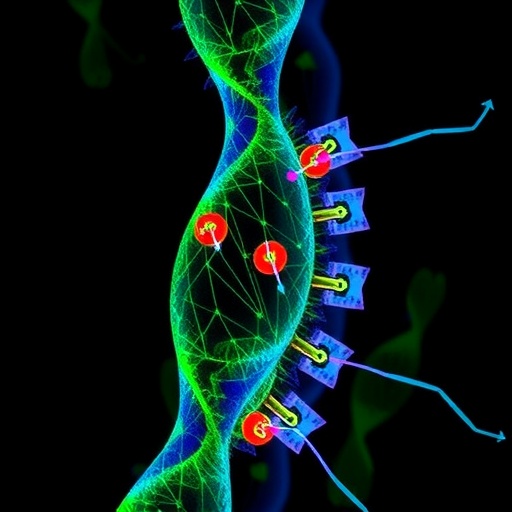In the intricate dance of meiosis, the faithful segregation of chromosomes is a process vital to the perpetuation of life across all eukaryotes. This critical event is orchestrated by a cascade of molecular interactions and mechanical forces that ensure homologous chromosomes recognize each other, align, and exchange genetic material with remarkable precision. A recent groundbreaking study has illuminated a previously elusive component of this choreography in the model plant Arabidopsis thaliana, deepening our understanding of meiotic chromosome behavior and the conserved nature of these mechanisms across kingdoms.
Meiotic prophase is characterized by dynamic chromosome movements that facilitate the search and pairing of homologous chromosomes. These so-called rapid prophase movements (RPMs) are driven by cytoskeletal motors and anchored to the nuclear envelope (NE) through a sophisticated bridge known as the Linker of Nucleoskeleton and Cytoskeleton (LINC) complex. In animals and fungi, LINC complexes — specifically SUN and KASH domain proteins — have been well-documented mediators of this process. Until now, plant systems lacked a clearly defined KASH component within the meiotic LINC apparatus, leaving a crucial gap in the understanding of plant chromosomal dynamics.
The study conducted by Cai et al. has decisively identified the KASH-domain protein SINE3 as the missing link in the plant LINC complex during meiosis. Their work reveals that Arabidopsis SUN-domain proteins SUN1 and SUN2 collaborate with SINE3 to form a functional LINC complex at the nuclear envelope. This complex is not merely structural; it recruits the meiosis-specific motor protein PSS1, a kinesin, to the NE, establishing a direct connection between cytoplasmic mechanical forces and chromosome movement.
.adsslot_DVkWbLNftZ{width:728px !important;height:90px !important;}
@media(max-width:1199px){ .adsslot_DVkWbLNftZ{width:468px !important;height:60px !important;}
}
@media(max-width:767px){ .adsslot_DVkWbLNftZ{width:320px !important;height:50px !important;}
}
ADVERTISEMENT
Functional interrogation of this complex uncovered its essential role at telomeric attachment sites on the NE. The telomere bouquet, a hallmark of meiotic prophase where telomeres cluster at the nuclear periphery, facilitates the homology search by promoting chromosome pairing. In mutants deficient for SUN1, SUN2, or SINE3, the bouquet configuration failed to form properly, resulting in impaired telomere attachment. This disruption essentially immobilized chromosomes in the nucleus, abolishing the characteristic RPMs crucial for homologous chromosome recognition.
Importantly, the loss of this LINC complex and its associated motor, PSS1, led to downstream consequences on synapsis – the intimate pairing of homologous chromosomes – which was significantly defective. The affected chromosomes exhibited clustered crossover events, indicating that recombination events became localized in a non-uniform manner. This aberrant crossover pattern predisposes chromosomes to mis-segregation during meiotic divisions, threatening genome stability in resultant gametes.
At the molecular level, SUN1 and SUN2 localized to telomere-binding domains on the inner nuclear membrane, establishing a platform for SINE3 engagement on the outer membrane side. The kinesin PSS1, known for its microtubule-based motor activity, is recruited by SINE3, thereby translating cytoskeletal forces into chromosomal motion. This discovery conclusively connects the dots between cytoplasmic motor proteins and nuclear chromosome dynamics during meiosis in plants.
The revelation that plants utilize a SUN-KASH-motor configuration akin to other eukaryotes underscores a deep evolutionary conservation of meiotic machinery. It demonstrates that the mechanical framework facilitating rapid chromosome movements is a fundamental feature, preserved despite the vast evolutionary distances separating plants from animals and fungi.
Moreover, the study highlights that in Arabidopsis, RPMs serve primarily to enhance recognition between homologous chromosomes rather than simply acting as a barrier to non-homologous interactions. This subtlety adds nuance to the classical model of meiotic homology search mechanisms, emphasizing the active role of motion in ensuring correct pairing fidelity.
The experimental approaches combined live cell imaging of meiotic nuclei, fluorescent tagging of key LINC and motor components, and detailed genetic analyses of mutant backgrounds. These complementary methods painted a comprehensive picture of the dynamic interplay between nuclear envelope proteins and cytoskeletal motors in real time during early meiosis.
Through their meticulous work, the authors provide compelling evidence that chromosome mobility, steered by the interplay of SUN-domain proteins, the newly identified KASH partner SINE3, and the motor PSS1, is indispensable for meiotic success. This advances our understanding not only of Arabidopsis meiosis but offers a framework to explore similar mechanisms in agronomically important crops, with potential implications for breeding and fertility.
The implications of this study are far-reaching. Beyond plant biology, the findings reinforce the paradigm that mechanical forces and nuclear architecture converge to orchestrate the spatiotemporal regulation of chromosome behavior during meiosis. This could inform medical genetics and fertility research where meiotic errors underpin aneuploidy and reproductive disorders.
In closing, Cai and colleagues have deftly filled a critical gap in the knowledge of plant meiosis by revealing the cytoplasmic motor–LINC complex that drives rapid chromosome movements. This discovery underscores the universality of meiotic mechanisms and opens new avenues for dissecting the molecular underpinnings of chromosome behavior, posing exciting new questions for future research on how mechanical forces shape the genome’s integrity across kingdoms.
Subject of Research:
Meiotic chromosome movement and homologous pairing mechanisms in Arabidopsis thaliana involving LINC complexes and cytoplasmic motor proteins.
Article Title:
Identification of the cytoplasmic motor–LINC complex involved in rapid chromosome movements during meiotic prophase in Arabidopsis thaliana.
Article References:
Cai, B., Tiscareno-Andrade, M., Luo, Y. et al. Identification of the cytoplasmic motor–LINC complex involved in rapid chromosome movements during meiotic prophase in Arabidopsis thaliana. Nat. Plants (2025). https://doi.org/10.1038/s41477-025-02043-4
Image Credits: AI Generated
Tags: Arabidopsis thaliana meiosiscytoplasmic motor functioncytoskeletal motors in meiosisgenetic material exchange in meiosishomologous chromosome pairingLINC complex in plantsmeiotic chromosome movementmeiotic prophase mechanismsnuclear envelope interactionsplant chromosome dynamicsrapid prophase movementsSUN and KASH proteins





